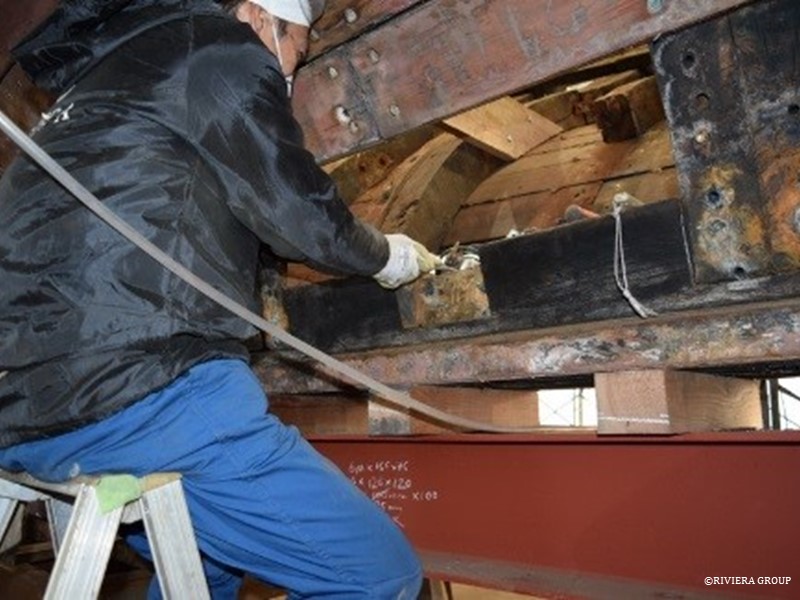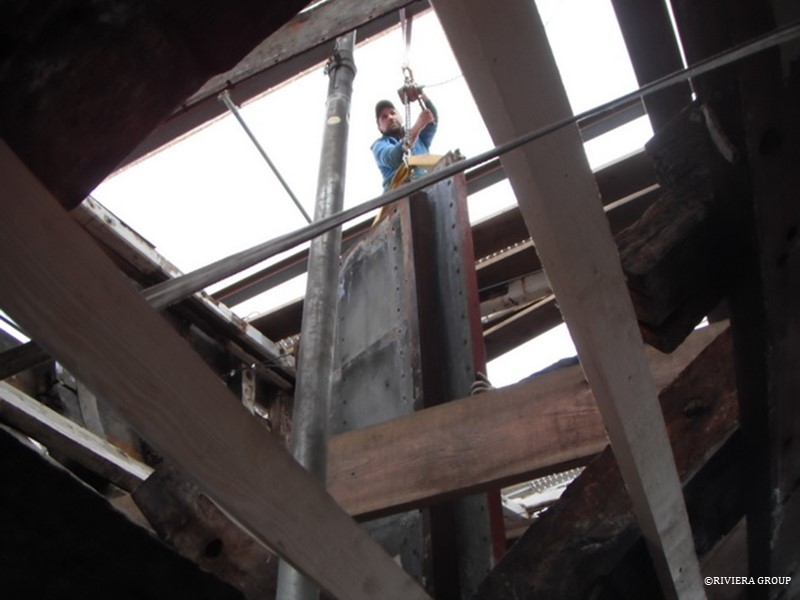
Blog — January, 2018
January, 2018
Carefully selected strakes, which are a run of planks from the stem to stern, are being removed by extracting the rivets and the ship nails (called dumps) with slide hammers and drifts. Kawashima (above) is drilling a hole into the head of a dump. It is then tapped with a thread before inserting the threaded end of a slide hammer and drawing it out.

A piece of string is tied through one of the holes to prevent the plank from springing out and falling to the ground when the opposite end is released. The planks may be very old, but they still retain their spring. The vertical tube is used as a water level in these early stages to monitor movement in the hull as strakes are released.

Nico Calderoni and Kawashima discuss a stubborn fastener.

After removal, the planks are cleaned, labelled, and stacked.

Ben is cleaning out the holes around the heads of the keel bolts. These are the long bolts that extend through the false keel, keel, and stern knee, and are difficult to remove.

Paul and Ben having one of their discussions on the plans with Takamiya.

Cleaning one of the sockets that housed a futtock, one of the curved rib-like timbers that make up the frame of the boat, after its removal.

Lewis is working on shaping one of the futtocks (above), and handing it to Nico, inside the boat (below) for a first fit.


The careful selection of strakes to be removed allows the boat shape to be manipulated more easily. Some strakes are left in place to act as ribbands, keeping the frames in place while alternate pairs of lower futtocks are removed.

The lower section of the false keel was finally separated from the boat.

Chuck Demangeat, Cynara’s rigger, is onsite to check the deck layout. He’s discussing the positions for new fittings with Paul (above). The positions will more or less match the old ones, but this has to be checked at an early stage so that deck fittings don’t collide with existing hull fastenings and the strong points can be built to take the anticipated stresses and loads of the rig on the hull. It was interesting to see the methods that the original builders used, something that can only be seen when the hull is stripped. After more than 90 years of use, it was also necessary to examine the condition of these areas.

Wooden ribbands are fitted low down in the hull to make sure that the new futtocks being installed are fair.

A chain block is used to remove a riveted steel bulkhead in the bow.

Nico is working on the lower stem section of the hull. There was no scaffolding at the time, so working with the heavy oak timbers off of ladders and benches was not easy.

Paul is fitting adjustable scaffold “legs” at select stations around the hull. These allow the sheer line to be maintained and tweaked where necessary. The legs are securely bolted to a heavy steel box section ribband that was stretched around the hull two plank levels below the sheer line. They also help keep the hull vertical during the boat’s deconstruction and through the frequent earth tremors that Japan experiences.

Nico and Lewis working on the futtocks under the hull.

Pascal is in the bilges, cutting thwarts and braces to make sure the hull in the bilge area keeps it shape.

Cynara is slowly getting her original shape back, based on the original drawings. The hull already looks fairer, but there’s more to do before she matches the drawings.

Clamps are used to secure the keel to the strong back I-beam. This is to take out any memory of the hog from the keel timber and ensure it stays flat and straight while work on Cynara continues. It also keeps the hull from moving during the random earthquakes.

